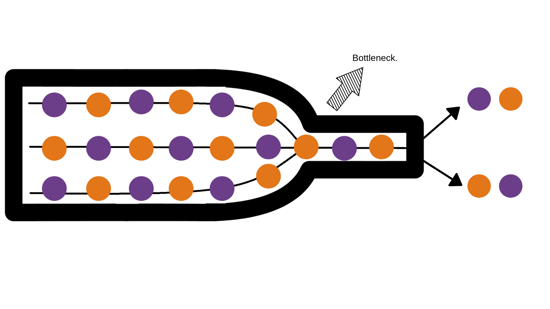Bottleneck Analysis
A bottleneck analysis is a lean management tool that looks at any areas within a process that are causing the workflow to become backed up or slower than it should be. A bottleneck analysis can help in identifying the exact point along the workflow that is causing these blockages, and work to mitigate them

If you look at the bottle above as an example, imagine the colored dots as the tasks within a process, and the lines they are on is how they are flowing. As you can see, when the tasks reach the neck of the bottle, they slow down and all have to get through the bottle at a slower rate.
The ‘neck’ of the bottle is where the constraints or wastes within the processes can be found. This may be a particular step in a manufacturing process, or perhaps an approval that needs to be made before all the tasks carry through to the next step. A bottleneck analysis will focus on finding out what these blockages are, and working to eliminate them.
Examples of Bottlenecks:
- Approvals
- Transportation logistics
- Communication
- Manufacturing processes
- Business processes
Benefits of the bottleneck analysis:
Once this blockage has been identified, improvements can be made that will aim to reduce the waste created from this workflow. Bottlenecks are often created by unnecessary or inefficient steps within a process, that ultimately just create waste. The bottleneck analysis will be able to identify where this waste is coming from, which can then be removed.
Another benefit is that the organisation will have an increased knowledge regarding their processes and workflows. This will help in the ability to make more informed decisions in the future that may stop more bottlenecks occurring.
How to conduct a bottleneck analysis:
The process to this tool is detailed and requires a lot data-gathering about processes, which may be time consuming for the organisation, but will be worth it in regards to costs saved and efficiencies gained.
It is important to remember that when you are performing a bottleneck analysis, you do not only want to look at the area the blockage is occurring, but the whole process, including steps prior to this and also after it. By doing this, you will be able to get useful information about what may cause this bottleneck to occur, and what the implications are afterwards. It is important to do this because if you eliminate a bottleneck at the start of the process, this may cause other implications further down the track.
When conducting the analysis the type of information you want to be gathering will relate to how long a step in the process may take, the costs associated with it, how many people are involved, and what steps are dependent on other ones being completed.
Once you have found out what the most crucial bottlenecks are, steps can be put in place to reduce them. This may involve introducing quality control and quality assurance before a bottleneck, or even having corrective action tools in place after the bottleneck.
If the bottleneck can be removed all together without any implications, then this would be the most effective and efficient thing to do.
Other Lean Management tools:




